Confirmation of Record 220 PeV Cosmic Neutrino Hit on Earth
Neutrinos are exceedingly common in the Universe, with billions of them zipping around us throughout the day from a variety of sources. Due to their extremely low mass and no electric charge they barely ever interact with other particles, making these so-called ‘ghost particles’ very hard to detect. That said, when they do interact the result is rather spectacular as they impart significant kinetic energy. The resulting flash of energy is used by neutrino detectors, with most neutrinos generally pegging out at around 10 petaelectronvolt (PeV), except for a 2023 event.
This neutrino event which occurred on February 13th back in 2023 was detected by the KM3NeT/ARCA detector and has now been classified as an ultra-high energy neutrino event at 220 PeV, suggesting that it was likely a cosmogenic neutrinos. When we originally reported on this KM3-230213A event, the data was still being analyzed based on a detected muon from the neutrino interaction even, with the researchers also having to exclude the possibility of it being a sensor glitch.
By comparing the KM3-230213A event data with data from other events at other detectors, it was possible to deduce that the most likely explanation was one of these ultra-high energy neutrinos. Since these are relatively rare compared to neutrinos that originate within or near Earth’s solar system, it’ll likely take a while for more of these detection events. As the KM3NeT/ARCA detector grid is still being expanded, we may see many more of them in Earth’s oceans. After all, if a neutrino hits a particle but there’s no sensor around to detect it, we’d never know it happened.
Top image: One of the photo-detector spheres of ARCA (Credit: KM3NeT)
hackaday.com/2025/08/26/confir…


